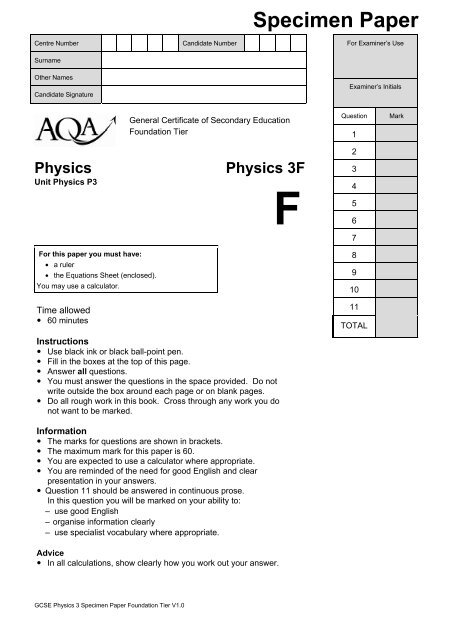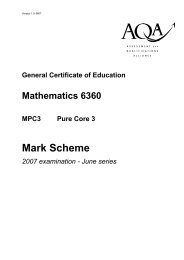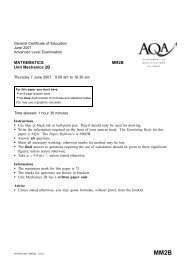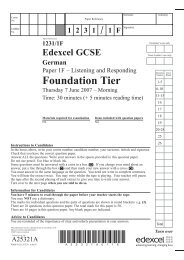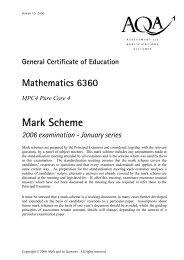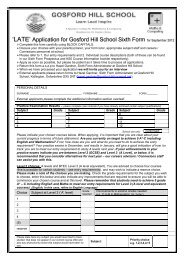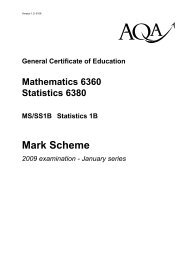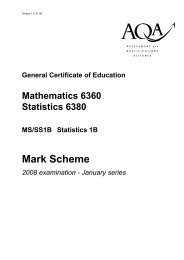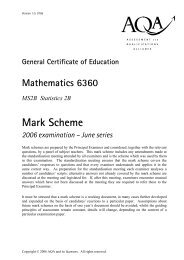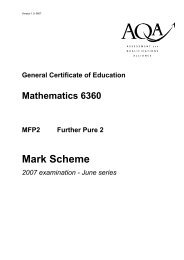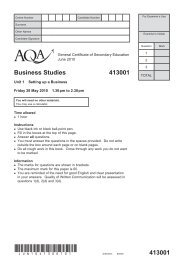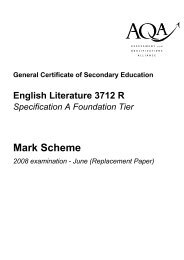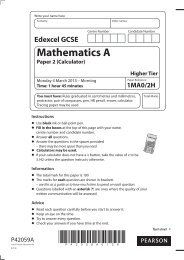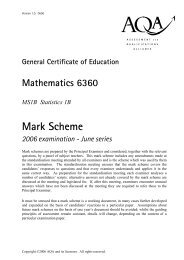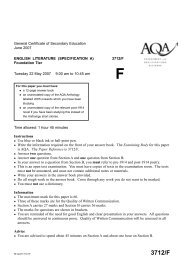GCSE Physics Specimen Question Paper Foundation ... - AQA
GCSE Physics Specimen Question Paper Foundation ... - AQA
GCSE Physics Specimen Question Paper Foundation ... - AQA
You also want an ePaper? Increase the reach of your titles
YUMPU automatically turns print PDFs into web optimized ePapers that Google loves.
<strong>Specimen</strong> <strong>Paper</strong><br />
Centre Number<br />
Surname<br />
Candidate Number<br />
For Examiner’s Use<br />
Other Names<br />
Candidate Signature<br />
Examiner’s Initials<br />
General Certificate of Secondary Education<br />
<strong>Foundation</strong> Tier<br />
<strong>Question</strong><br />
1<br />
Mark<br />
<strong>Physics</strong><br />
Unit <strong>Physics</strong> P3<br />
For this paper you must have:<br />
• a ruler<br />
• the Equations Sheet (enclosed).<br />
You may use a calculator.<br />
<strong>Physics</strong> 3F<br />
F<br />
2<br />
3<br />
4<br />
5<br />
6<br />
7<br />
8<br />
9<br />
10<br />
Time allowed<br />
! 60 minutes<br />
Instructions<br />
! Use black ink or black ball-point pen.<br />
! Fill in the boxes at the top of this page.<br />
! Answer all questions.<br />
! You must answer the questions in the space provided. Do not<br />
write outside the box around each page or on blank pages.<br />
! Do all rough work in this book. Cross through any work you do<br />
not want to be marked.<br />
11<br />
TOTAL<br />
Information<br />
! The marks for questions are shown in brackets.<br />
! The maximum mark for this paper is 60.<br />
! You are expected to use a calculator where appropriate.<br />
! You are reminded of the need for good English and clear<br />
presentation in your answers.<br />
! <strong>Question</strong> 11 should be answered in continuous prose.<br />
In this question you will be marked on your ability to:<br />
– use good English<br />
– organise information clearly<br />
– use specialist vocabulary where appropriate.<br />
Advice<br />
! In all calculations, show clearly how you work out your answer.<br />
<strong>GCSE</strong> <strong>Physics</strong> 3 <strong>Specimen</strong> <strong>Paper</strong> <strong>Foundation</strong> Tier V1.0
2<br />
Do not write<br />
outside the<br />
box<br />
Answer all questions in the spaces provided.<br />
1 (a) The diagram shows the cross-section of an eye.<br />
C ...........................<br />
A ...........................<br />
B ...........................<br />
Use words from the box to label the parts, A, B and C.<br />
cornea iris lens pupil retina<br />
(3 marks)<br />
1 (b) The diagram shows one of the eyes of a person who is short-sighted.<br />
Which one of the following lenses, J, K or L, could be used to correct the person’s<br />
eyesight<br />
Give a reason for your choice.<br />
Lens .......................................................<br />
.............................................................................................................................................<br />
.............................................................................................................................................<br />
(2 marks)<br />
5<br />
<strong>GCSE</strong> <strong>Physics</strong> 3 <strong>Specimen</strong> <strong>Paper</strong> <strong>Foundation</strong> Tier V1.0
3<br />
Do not write<br />
outside the<br />
box<br />
2 The picture shows a fairground carousel.<br />
The diagram shows the position of one child, at one point in the ride, viewed from above.<br />
Picture<br />
Diagram<br />
Draw a ring around the correct answer to complete the following sentences.<br />
2 (a) The resultant force needed to keep the child moving in a circular path is<br />
centripetal<br />
called the<br />
circular<br />
force.<br />
gravitational<br />
(1 mark)<br />
A.<br />
2 (b) The resultant force on the child acts in the direction<br />
B.<br />
C.<br />
(1 mark)<br />
2 (c) At the end of the ride, as the carousel slows down, the resultant force on<br />
decreases.<br />
the child<br />
stays the same.<br />
increases.<br />
<strong>GCSE</strong> <strong>Physics</strong> 3 <strong>Specimen</strong> <strong>Paper</strong> <strong>Foundation</strong> Tier V1.0<br />
(1 mark)<br />
Turn over!<br />
3
4<br />
Do not write<br />
outside the<br />
box<br />
3 The drawing shows a car tyre, which is hanging from the branch of a tall tree.<br />
To tree<br />
Thick rope<br />
3 (a) Draw an X on the diagram to mark the centre of mass of the tyre.<br />
(1 mark)<br />
3 (b) Some children use the tyre as a swing. Pulling the tyre to one side and letting it go<br />
makes the tyre swing backwards and forwards like a pendulum.<br />
The time it takes the tyre to swing from one side to the other and back again is called the<br />
time period.<br />
<strong>GCSE</strong> <strong>Physics</strong> 3 <strong>Specimen</strong> <strong>Paper</strong> <strong>Foundation</strong> Tier V1.0
5<br />
Do not write<br />
outside the<br />
box<br />
3 (b) (i) What is the unit for time period<br />
............................................................................................................................................<br />
(1 mark)<br />
3 (b) (ii) How would using a shorter rope change the time period of the swing<br />
............................................................................................................................................<br />
............................................................................................................................................<br />
(1 mark)<br />
3<br />
Turn over for the next question<br />
Turn over!<br />
<strong>GCSE</strong> <strong>Physics</strong> 3 <strong>Specimen</strong> <strong>Paper</strong> <strong>Foundation</strong> Tier V1.0
6<br />
Do not write<br />
outside the<br />
box<br />
4 The diagram shows a transformer made by a student. The student has designed the<br />
transformer to make a 6 V light bulb work using a 2 V power supply.<br />
4 (a) Draw a ring around the correct answer to complete the following sentences.<br />
must use an a.c.<br />
4 (a) (i) For the transformer to work, the student can use either an a.c. or a d.c. power supply.<br />
must use a d.c.<br />
(1 mark)<br />
4 (a) (ii) On the primary coil there are 30 turns of wire. For the lamp to work brightly there must<br />
less than 30<br />
be<br />
exactly 30<br />
more than 30<br />
turns of wire on the secondary coil.<br />
(1 mark)<br />
4 (b) What is the transformer core made from<br />
Give a reason for your answer.<br />
............................................................................................................................................<br />
............................................................................................................................................<br />
............................................................................................................................................<br />
............................................................................................................................................<br />
(2 marks)<br />
4<br />
<strong>GCSE</strong> <strong>Physics</strong> 3 <strong>Specimen</strong> <strong>Paper</strong> <strong>Foundation</strong> Tier V1.0
7<br />
Do not write<br />
outside the<br />
box<br />
Turn over for the next question<br />
DO NOT WRITE ON THIS PAGE<br />
ANSWER IN THE SPACES PROVIDED<br />
Turn over!<br />
<strong>GCSE</strong> <strong>Physics</strong> 3 <strong>Specimen</strong> <strong>Paper</strong> <strong>Foundation</strong> Tier V1.0
8<br />
Do not write<br />
outside the<br />
box<br />
5 (a) Each diagram shows a light ray incident on a glass–air boundary.<br />
The critical angle for glass is 42°.<br />
Which one of the diagrams, A, B, C or D, shows total internal reflection<br />
Write the correct letter in the box.<br />
(1 mark)<br />
5 (b) (i) Complete the diagram to show the path taken by the light ray as it travels through the<br />
optical fibre.<br />
(2 marks)<br />
<strong>GCSE</strong> <strong>Physics</strong> 3 <strong>Specimen</strong> <strong>Paper</strong> <strong>Foundation</strong> Tier V1.0
9<br />
Do not write<br />
outside the<br />
box<br />
5 (b) (ii) The diagram shows an endoscope being used by a doctor to look inside a patient’s<br />
stomach. Light travels into the stomach through a bundle of optical fibres.<br />
The following sentences describe how the endoscope allows the doctor to see inside the<br />
patient’s stomach. The sentences are in the wrong order.<br />
Q Light passes through a bundle of optical fibres into the patient’s stomach.<br />
R The inside of the stomach reflects some of the light.<br />
S The optical fibres take the light to an eyepiece.<br />
T The doctor looks through the eyepiece to see inside the patient’s stomach.<br />
U The reflected light passes through a second bundle of optical fibres.<br />
Arrange these sentences in the correct order. Start with letter Q.<br />
Q<br />
(3 marks)<br />
6<br />
Turn over for the next question<br />
Turn over!<br />
<strong>GCSE</strong> <strong>Physics</strong> 3 <strong>Specimen</strong> <strong>Paper</strong> <strong>Foundation</strong> Tier V1.0
10<br />
Do not write<br />
outside the<br />
box<br />
6 The ray diagram shows a lens being used as a magnifying glass.<br />
The diagram has been drawn to scale.<br />
6 (a) What name is given to the type of lens used as a magnifying glass<br />
.............................................................................................................................................<br />
(1 mark)<br />
6 (b) Calculate the magnification produced by the lens.<br />
Write down the equation you use, and then show clearly how you work out your answer.<br />
............................................................................................................................................<br />
............................................................................................................................................<br />
............................................................................................................................................<br />
............................................................................................................................................<br />
............................................................................................................................................<br />
............................................................................................................................................<br />
Magnification = .....................................................<br />
(2 marks)<br />
<strong>GCSE</strong> <strong>Physics</strong> 3 <strong>Specimen</strong> <strong>Paper</strong> <strong>Foundation</strong> Tier V1.0
11<br />
Do not write<br />
outside the<br />
box<br />
6 (c) Describe the image produced by a magnifying glass.<br />
............................................................................................................................................<br />
............................................................................................................................................<br />
............................................................................................................................................<br />
(3 marks)<br />
Turn over for the next question<br />
6<br />
Turn over!<br />
<strong>GCSE</strong> <strong>Physics</strong> 3 <strong>Specimen</strong> <strong>Paper</strong> <strong>Foundation</strong> Tier V1.0
12<br />
Do not write<br />
outside the<br />
box<br />
7 (a) The diagram shows a gardener using a steel bar to lever a tree stump out of the ground.<br />
When the gardener pushes with a force of 300 N the tree stump just begins to move.<br />
Calculate the moment produced by the gardener on the steel bar.<br />
Write down the equation you use, and then show clearly how you work out your answer<br />
and give the unit.<br />
............................................................................................................................................<br />
............................................................................................................................................<br />
............................................................................................................................................<br />
............................................................................................................................................<br />
............................................................................................................................................<br />
............................................................................................................................................<br />
Moment = ...............................................<br />
(4 marks)<br />
<strong>GCSE</strong> <strong>Physics</strong> 3 <strong>Specimen</strong> <strong>Paper</strong> <strong>Foundation</strong> Tier V1.0
13<br />
Do not write<br />
outside the<br />
box<br />
7 (b) Using a longer steel bar would have made it easier for the gardener to lever the tree<br />
stump out of the ground.<br />
Explain why.<br />
............................................................................................................................................<br />
............................................................................................................................................<br />
............................................................................................................................................<br />
............................................................................................................................................<br />
............................................................................................................................................<br />
(3 marks)<br />
7<br />
Turn over for the next question<br />
Turn over!<br />
<strong>GCSE</strong> <strong>Physics</strong> 3 <strong>Specimen</strong> <strong>Paper</strong> <strong>Foundation</strong> Tier V1.0
14<br />
Do not write<br />
outside the<br />
box<br />
8 The diagram shows a simple hydraulic jack. The jack is designed to lift a large weight<br />
using a much smaller force.<br />
8 (a) Complete the following sentence.<br />
A hydraulic jack is an example of a ...................................................... multiplier.<br />
(1 mark)<br />
8 (b) Calculate the pressure, in N/cm 2 , created on the small piston by the force of 50 N<br />
pushing downwards.<br />
Write down the equation you use, and then show clearly how you work out your answer.<br />
............................................................................................................................................<br />
............................................................................................................................................<br />
............................................................................................................................................<br />
............................................................................................................................................<br />
............................................................................................................................................<br />
............................................................................................................................................<br />
8 (c) Complete the following sentence.<br />
Pressure = ................................................. N/cm 2<br />
(2 marks)<br />
The pressure at Y will be ...................................................................... the pressure at X.<br />
(1 mark)<br />
4<br />
<strong>GCSE</strong> <strong>Physics</strong> 3 <strong>Specimen</strong> <strong>Paper</strong> <strong>Foundation</strong> Tier V1.0
15<br />
Do not write<br />
outside the<br />
box<br />
9 The diagram shows the equipment used by a student to investigate the strength of five<br />
different electromagnets.<br />
The stronger the electromagnet, the more paper clips it will hold.<br />
9 (a) Why is it important that the paper clips used in the investigation are all the same size<br />
............................................................................................................................................<br />
............................................................................................................................................<br />
............................................................................................................................................<br />
(1 mark)<br />
<strong>Question</strong> 9 continues on the next page<br />
<strong>GCSE</strong> <strong>Physics</strong> 3 <strong>Specimen</strong> <strong>Paper</strong> <strong>Foundation</strong> Tier V1.0
16<br />
9 (b) The five electromagnets, J, K, L, M and N, used by the student are shown below.<br />
Each electromagnet was made by wrapping lengths of insulated wire around identical<br />
iron nails.<br />
The student wants to find out how the strength of an electromagnet depends on the<br />
number of turns of wire in the coil.<br />
Which electromagnets should the student compare in order to do this<br />
............................................................................................................................................<br />
(1 mark)<br />
9 (c) The student concluded:<br />
‘The strength of an electromagnet is always directly proportional to the number of turns<br />
on the coil.’<br />
9 (c) (i) Explain how the data from the investigation supports the student’s conclusion.<br />
............................................................................................................................................<br />
............................................................................................................................................<br />
............................................................................................................................................<br />
............................................................................................................................................<br />
............................................................................................................................................<br />
(2 marks)<br />
<strong>GCSE</strong> <strong>Physics</strong> 3 <strong>Specimen</strong> <strong>Paper</strong> <strong>Foundation</strong> Tier V1.0
17<br />
Do not write<br />
outside the<br />
box<br />
9 (c) (ii) The student makes one more electromagnet by winding 100 turns onto a nail.<br />
Before testing the electromagnet, the student predicted the number of paper clips that<br />
the electromagnet would hold when the current is 1 amp.<br />
How many paper clips should the student predict that the electromagnet would hold<br />
Show clearly how you work out your answer.<br />
............................................................................................................................................<br />
............................................................................................................................................<br />
............................................................................................................................................<br />
Number of paper clips = ........................................<br />
(2 marks)<br />
9 (c) (iii) When the student tested the electromagnet it held 20 paper clips.<br />
This is not what the student predicted.<br />
Explain what the student should do when new data does not seem to support the<br />
prediction that was made.<br />
............................................................................................................................................<br />
............................................................................................................................................<br />
............................................................................................................................................<br />
............................................................................................................................................<br />
............................................................................................................................................<br />
............................................................................................................................................<br />
............................................................................................................................................<br />
(3 marks)<br />
9<br />
<strong>GCSE</strong> <strong>Physics</strong> 3 <strong>Specimen</strong> <strong>Paper</strong> <strong>Foundation</strong> Tier V1.0
18<br />
10 Both X-ray machines and CT scanners are used to produce images of the body.<br />
10 (a) The diagram shows an X-ray photograph of a broken leg.<br />
Before switching on the X-ray machine, the radiographer goes behind a screen.<br />
Explain why the radiographer does this.<br />
............................................................................................................................................<br />
............................................................................................................................................<br />
............................................................................................................................................<br />
............................................................................................................................................<br />
............................................................................................................................................<br />
............................................................................................................................................<br />
............................................................................................................................................<br />
(3 marks)<br />
<strong>GCSE</strong> <strong>Physics</strong> 3 <strong>Specimen</strong> <strong>Paper</strong> <strong>Foundation</strong> Tier V1.0
19<br />
Do not write<br />
outside the<br />
box<br />
10 (b) The following is an extract from a newspaper article.<br />
X-rays cause 700 new cancers each year in the UK<br />
Each year there are about 125 000 new cancer cases in the UK, of<br />
which about 700 may be due to the use of X-rays to diagnose<br />
illness.<br />
The article was reporting on a scientific research project first published in a medical<br />
journal.<br />
What evidence would the scientists have collected to come to the conclusion that X-rays<br />
can cause cancer<br />
............................................................................................................................................<br />
............................................................................................................................................<br />
............................................................................................................................................<br />
............................................................................................................................................<br />
............................................................................................................................................<br />
(2 marks)<br />
10 (c) Explain the advantage of a CT scan compared to an X-ray.<br />
............................................................................................................................................<br />
............................................................................................................................................<br />
............................................................................................................................................<br />
............................................................................................................................................<br />
............................................................................................................................................<br />
(2 marks)<br />
7<br />
<strong>GCSE</strong> <strong>Physics</strong> 3 <strong>Specimen</strong> <strong>Paper</strong> <strong>Foundation</strong> Tier V1.0
20<br />
11 In this question you will be assessed on using good English, organising information clearly<br />
and using specialist terms where appropriate.<br />
The diagrams show a relay switch and how it is used in a car ignition circuit.<br />
Turning the ignition key closes the ignition switch.<br />
Explain how this causes the starter motor to operate.<br />
............................................................................................................................................<br />
............................................................................................................................................<br />
............................................................................................................................................<br />
............................................................................................................................................<br />
............................................................................................................................................<br />
............................................................................................................................................<br />
............................................................................................................................................<br />
............................................................................................................................................<br />
............................................................................................................................................<br />
(6 marks)<br />
Copyright © 2011 <strong>AQA</strong> and its licensors. All rights reserved<br />
END OF QUESTIONS<br />
6<br />
<strong>GCSE</strong> <strong>Physics</strong> 3 <strong>Specimen</strong> <strong>Paper</strong> <strong>Foundation</strong> Tier V1.0
21<br />
<strong>GCSE</strong> <strong>Physics</strong> Equations Sheet<br />
hij<br />
Unit 3 F<br />
s distance<br />
v speed<br />
t time<br />
i<br />
r<br />
the angle of incidence<br />
the angle of refraction<br />
P power of the lens<br />
f focal length<br />
T<br />
f<br />
periodic time<br />
frequency<br />
M moment of the force<br />
F force<br />
d perpendicular distance from the line of action of the<br />
force to the pivot<br />
P pressure<br />
F force<br />
A cross-sectional area<br />
V p potential difference across the primary coil<br />
V s potential difference across the secondary coil<br />
n p number of turns on the primary coil<br />
number of turns on the secondary coil<br />
n s<br />
V p potential difference across the primary coil<br />
l p current in the primary coil<br />
V s potential difference across the secondary coil<br />
current in the secondary coil<br />
I s<br />
<strong>GCSE</strong> <strong>Physics</strong> 3 <strong>Specimen</strong> <strong>Paper</strong> <strong>Foundation</strong> Tier V1.0


